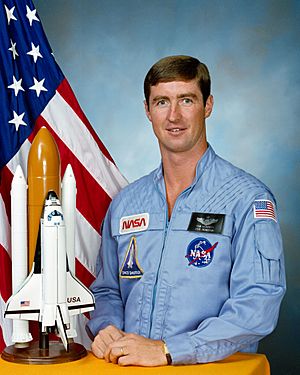Terence T. Henricks facts for kids
Quick facts for kids
Tom Henricks
|
|
|---|---|
 |
|
| Born |
Terence Thomas Henricks
July 5, 1952 Bryan, Ohio, U.S.
|
| Space career | |
| NASA astronaut | |
| Rank | Colonel, USAF |
|
Time in space
|
42d 18h 38m |
| Selection | NASA Group 11 (1985) |
| Missions | STS-44 STS-55 STS-70 STS-78 |
|
Mission insignia
|
|
Terence Thomas "Tom" Henricks, born on July 5, 1952, is a brave former NASA astronaut and a retired colonel from the United States Air Force. He flew into space on four exciting Space Shuttle missions, exploring beyond Earth.
Contents
Tom Henricks' Early Life and Education
Tom Henricks was born in Bryan, Ohio. However, he considers Woodville, Ohio, his true hometown. He finished high school at Woodmore High School in 1970. He then went on to earn a degree in Civil Engineering from the United States Air Force Academy in 1974. Later, in 1982, he received another degree from Golden Gate University. Tom Henricks is married to Rebecca and they have three children. They currently live in Blanco, Texas.
Amazing Awards and Honors
Tom Henricks has received many special awards for his bravery and hard work. These include:
- The Distinguished Flying Cross
- The NASA Outstanding Leadership Medal
- The Defense Superior Service Medal
- The Defense Meritorious Service Medal
- Air Force Meritorious Service Medals
- Air Force Commendation Medals (2)
- NASA Space Flight Medals (4)
- An honorary Doctor of Science degree from Defiance College (1993)
- The F-4 Fighter Weapons School Outstanding Flying Award
- Being named Pilot Training Distinguished Graduate and F-16 Conversion Course Top Gun
- Being added to the Ohio Veterans Hall of Fame
Tom Henricks' Military and Flight Adventures
Tom Henricks started his pilot training at Craig Air Force Base in Selma, Alabama. He then learned to fly the F-4 Phantom II jet. He flew the F-4 in fighter groups in England and Iceland. In 1980, he moved to Nellis Air Force Base in Las Vegas, Nevada.
After attending the USAF Test Pilot School in 1983, he became an F-16C test pilot. He was also the Chief of the 57th Fighter Weapons Wing Operating Location at Edwards Air Force Base in California. Tom Henricks has made 749 parachute jumps and is a Master Parachutist. He has flown 30 different types of aircraft and has spent over 6,000 hours flying! He also holds a commercial pilot license.
Becoming a NASA Astronaut
NASA chose Tom Henricks to be an astronaut in June 1985. By July 1986, he officially became an astronaut. He worked on many important tasks, like checking out Space Shuttle landing sites around the world. He also helped manage the Shuttle Program Office.
He was the lead astronaut for the Shuttle Avionics Integration Laboratory at Johnson Space Center. He also led the Vehicle Test and Checkout at the Kennedy Space Center. Tom Henricks even became the Chief of the Astronaut Office Operations Development Branch. He helped guide astronauts in developing and operating the Space Shuttle.
Tom Henricks commanded two Space Shuttle missions and was the pilot for two others. He was the first person to spend over 1,000 hours as a Space Shuttle pilot or commander! He left government service in November 1997 to work in business. He was the President of McGraw-Hill's Aviation Week in New York City until 2010.
Tom Henricks' Space Missions
Tom Henricks flew on four amazing Space Shuttle missions. Each mission had important goals and helped us learn more about space.
STS-44: Launching a Satellite
STS-44 aboard the Atlantis launched on November 24, 1991. The main goal was to launch a special satellite called a Defense Support Program (DSP) satellite. This satellite helped with defense. The mission lasted for 110 orbits around Earth. It landed on December 1, 1991, at Edwards Air Force Base, California.
STS-55: German Spacelab Mission
STS-55, also known as the German D-2 Spacelab mission, launched on April 26, 1993. It flew on the Columbia. The mission lasted 10 days, landing on May 6, 1993, at Edwards AFB California. During this busy mission, the crew performed 89 experiments! These experiments covered many areas, like how materials behave in space, life sciences, robotics, and even mapping Earth.
STS-70: Deploying a Tracking Satellite
STS-70 launched from the Kennedy Space Center, Florida, on July 13, 1995. It returned to the same place on July 22, 1995. The crew orbited Earth 142 times. They did many experiments and also launched the sixth and final NASA Tracking and Data Relay Satellite. This satellite helps communicate with spacecraft. STS-70 was special because it had an "all-Ohio" crew and was the first mission controlled from a new combined control center.
STS-78: Longest Shuttle Mission (at the time!)
STS-78 launched on June 20, 1996, and landed on July 7, 1996. This mission became the longest Space Shuttle mission up to that point! (Later that year, STS-80 broke its record by 19 hours.) This 16-day mission included studies from 10 different countries and five space agencies. It was the first mission to combine both microgravity studies (how things behave in very low gravity) and life science investigations. This mission helped set the stage for future studies on the International Space Station.

